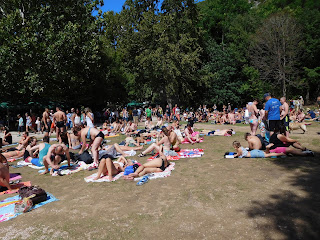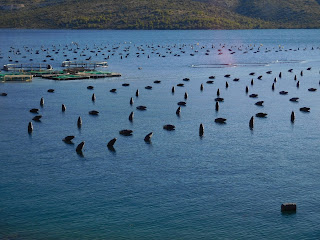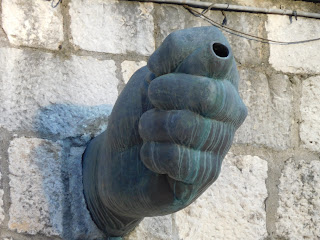One of the few day tours we had planned months ago was one
with Splitlicious to Krka National
Park Sibenik . We had to meet the guide at the Grgur Ninski statue outside the Golden Gate at 7:45. Luckily we had been there already so that made it easy so early in the morning.
Our tour guide, Duje, mentioned that Split’s population is about 200,000, the city is the second largest one in the country after Zagreb and has the busiest port in the Mediterranean after Piraeus in Athens and Marseilles in France. Diocletian chose to build his palace in this location not only because he had been born nearby in Salona but also because of its proximity to sulphur springs.
As we drove toward the park, Duje said that in the 1970s and 80s, about 11,000 people worked
in the shipyards in Split; now only 3,000 do. The famous limestone from Split's nearby forests looks like just
like marble, Duje said, and parts of the White House were constructed using
stone from Hvar.
We only had a short while to wait in Skradin before getting the 20 minute boat ride to Krka Falls National Park:
Our first views of the falls:
We had to walk on the bridge below later going in both directions and the masses of people walking shoulder to shoulder on the fairly narrow bridge were incredible. The place is so incredibly picturesque that many people (myself included) stoped every dozen feet or so to take photos which just created such a bottleneck. Thank goodness there was no stampede as it would have been a nightmare.
The water in the shallow pools was as clear as can be.
We came across one of the park's recreated mills. Up until the 1960s, almost every family living near the Krka River produced cloth from sheep wool. Freshly woven cloth was processed in a technical device called a fulling mill so it would soften and become more compact for the production of blankets, bedding, bags and, before the 1940s, clothes. Fulling lasted for several hours; then the clothes were placed on fences and stone fences to dry in the sun.
A fulling mill:
A washing basket:
The flour mill:
We saw a display of interesting wicker items in a nearby building. The Krka river basin is rich with brushlike willow which was used to make baskets for domestic use and for transporting hay. In the mid 19th century, wickerwork developed into a handicraft and it remained an extra source of income until the end of the 20th century.





Our tour guide, Duje, mentioned that Split’s population is about 200,000, the city is the second largest one in the country after Zagreb and has the busiest port in the Mediterranean after Piraeus in Athens and Marseilles in France. Diocletian chose to build his palace in this location not only because he had been born nearby in Salona but also because of its proximity to sulphur springs.
Our first stop was the youngest national park in Croatia ,
Krka Waterfalls, that became part of the parks system in 1985, Duje said. After
a 90 minute ride, the bus stopped in Skradin, the town adjacent to the
park. As the park has so many waterfalls, it’s considered by many Croatians
as the most beautiful park. Not only are there the many falls to explore but a
number of 19th century mills and also the remains of the Krka power plant that went
into existence first in 1895, just two days after Niagara Falls, Duje said.
We only had a short while to wait in Skradin before getting the 20 minute boat ride to Krka Falls National Park:
We arrived at the park about 10:30
so we had almost 3.5 hours by ourselves to go hiking, swim in the falls or
whatever we felt like doing. We were surprised at the masses of people there
already but Duje said that was nothing! There appeared to be the longest line
of ants, i.e. people, all following each other on the one hiking trail into the park.
We decided to go in the opposite direction in an attempt to beat the crowds by starting at
the end and just going around the other way. That was one of the smarter moves
we’ve ever made, let me tell you!
Our first views of the falls:
The Manjlovac Waterfall is the
highest on the Krka River
There were tiny falls everywhere we looked.
Photos of the big falls from the viewpoint: This was the
only place in the park you can swim and it was packed!
We had to walk on the bridge below later going in both directions and the masses of people walking shoulder to shoulder on the fairly narrow bridge were incredible. The place is so incredibly picturesque that many people (myself included) stoped every dozen feet or so to take photos which just created such a bottleneck. Thank goodness there was no stampede as it would have been a nightmare.
The water in the shallow pools was as clear as can be.
I read one of the park information signs and discovered
there are 46 species of mammals in the park including wild boars, river otters
and jackals. I just hoped we'd miss the boars and jackals!
Steven threw some bread in the water; it was amazing how
quickly the fish gobbled it up!
This was one of our favorite hikes especially since we had no crowds to contend with. The park was just stunning and almost each turn led us to even more falls to enjoy.A fulling mill:
The flour mill:
We saw a display of interesting wicker items in a nearby building. The Krka river basin is rich with brushlike willow which was used to make baskets for domestic use and for transporting hay. In the mid 19th century, wickerwork developed into a handicraft and it remained an extra source of income until the end of the 20th century.
Sample of the travertine Krka is so well known for:
Entrance to the Krka Falls power plant that opened just two days after Niagara
Falls .
There was a fairly extensive exhibit on Tesla but I had learned enough about him when we had visited the museum named for him in Belgrade so I skipped over it here!
Yes, I know we've seen many thousands of ducks in our time but these were cute and were the perfect addition to make our hike even better!
I loved looking at the clumps of bright green, flattened grasses in the clear water.
At the end of the trail was the tiny Church of St. Nicholas, the patron saint of travelers and seafarers. It was built in 1761 of dripstone which is deposited calcium carbonate. The church was closed.

We had had a really fun time walking in the park but were glad we had left ourselves enough time to relax by the falls. We had lugged our swim stuff with us this whole time and had planned on swimming but there were no changing rooms.
People therefore just stripped as they tried to change
clothes behind towels, etc. I wish you could have seen the contortionist
movements made by women as they wriggled in and out of clothes into
swimsuits or vice versa as their men chivalrously held up towels in often vain attempts to guard their privacy! Since our towels are little larger than hand towels and weigh next
to nothing, they were not designed to be of any use here. I sure would have
needed a bath sheet if I had entertained any thoughts of changing!
The only smidge of grass for the sun worshippers and picnickers:
I dipped my toes in the water but Steven had his 'swimsuit' on and went in for all of two minutes before we had to face the crowds going back across the footbridge to meet the bus.
Looks like he sure had lots of fun, doesn't it!
Just before we left, I finally saw some of the dried figs and sugared almonds
available for purchase from the “peasants” in the park that our guide, Duje, had told us about earlier.
Thank goodness we had alotted ourselves enough time on the bridge as it was slow going.
After everyone on the bus was kept waiting for 20 minutes
past our expected departure time by two dawdlers, we were finally on our
way to Sibenik to see another UNESCO-listed town. It was created during the 11th century by Croats and
was the seat of the Croatian kingdom who ruled from there. It was protected in
a natural bay from winds and the sea and was never conquered by the Turks
unlike most other cities in Croatia .
Once we arrived, Duje led us along the waterfront to the cathedral and said we had 75 minutes to 'explore' the town, including its fortresses and get something to eat. He had originally planned only on allowing us 45 minutes so we were happy with the extra time!
Sibenik waterfront:
What a gorgeous promenade!
Duje explained there are four fortresses in town: one by the sea and three
in the hills. There are about 40,000 people in Sibenik.
The cathedral was up these stairs:
Didn't have time to figure out who this was!
The Church of St. Barbara:
The Cathedral of St. James is one of the best preserved cathedrals entirely made of stone. Built in the 15th and 16th centuries,the Cathedral is a mixture of Gothic and Renaissance styles and made by an interlocking system of dry stone slabs.
What a profound difference between the clean and unclean
portions of the Cathedral! Approximately 600 years of grime that had
accumulated from the burning of candles and a nearby heavy metal factory which
traveled in the thin air had caused the buildup, I was told. It will take
another eight years to finish cleaning the Cathedral.

There were about six altars in the gorgeous cathedral. This was but one of them:
This Baroque altar called 'Lady of Carmel' had a wooden statue of the Mother of God done in 1617.


The Cathedral Baptistery was utterly sublime in my opinion. The entire upper part was covered by exquisite lace-like sculptures.
The ceiling even had statues and reliefs of angels!
The Baptisal Font is the center of the entire room and was made using reddish rock and is supported by three angels in natural and relaxed poses with each one leaning against each other. The Baptistery was recently cleaned from centuries of accumulation of dirt and smoke.
We felt like we were in a time
crunch so left the Cathedral to discover more of Sibenik. We hiked to the very
pretty cave of the Lady of
Lourdes located in the Garden
of St. Lawrence Monastery but didn't take time then to see the garden
We next climbed up to St. Michael’s Fortress but, once we got to the
top, Steven suggested we turn around because of the steep admission price and because we didn't have the time to do it justice.
The Garden of St. Lawrence Monastery that we hadn't seen on the way past earlier:
After walking down from the Fortress, we had a little bit of time to walk
through the medieval passageways of the small town.
All the shutters were the same shade of very dark green.
Wonder if that is one of the stipulations from UNESCO that none can be changed?
I bought a lovely memento of Sibenik from this artist.
A plaque on the side of a building honoring those from Sibenik who had died during WWII.
As we walked through town, we passed an open door and peered
in. It was only then that we looked up and noticed it was a church even though
we didn’t see any sign inside or outside. I had never seen a nautical themed
church like this one before. Keith: I know you and Lil aren’t much into
churches but, given your love of sailing, I think you both would have loved
this one in Sibenik!

After the ornateness of the Cathedral, I found this church delightful.
The ceiling:
We had a few extra minutes so walked by the port once again on our way back to the Cathedral. We both wished we had had a few hours to spend in Sibenik as it was so lovely.
I was glad we had a couple of minutes to look in more detail at some of the heads and notice how different each one was from each other.
The portraits outside the Cathedral were of ordinary people
of Sibenik and were supposed to represent the humanistic spirit of the
Renaissance that existed during that period. The people depicted were fishermen and
peasants and not the nobles, etc from the higher social classes. In that way,
it’s unlike any other Renaissance building of that period, Duje said.
As we hurried back to the bus, I was able to take a long
range photo of the Statue of King Peter IV who ruled Sibenik at some point way
back when!
Views from the van as we drove back to Split along the Dalmatian Coast. How much more beautiful a sight than this can you imagine? We just passed one more striking island after another.
The van stopped at a viewpoint so we could all jump out and look at this stunning sight of Primosten which had been an island until it was joined to the mainland.
The Dalmatian coast is well known for its wines, Duje said.
After getting back to Split, we walked back to our Airbnb and passed again the sculpture of the large fist on the side of a building. I asked a local about it and he said it was the Croatian way of giving someone the finger.
Natalie: Dad and I saw this poster for Yacht Week and thought of you.
What a really great and totally relaxing day we had had at the national park, the amazing Cathedral in Sibenik and then the stunning vistas of the Dalmatian Coast and, of course, Primosten.
Posted from Cetinje, Montenegro on September 16th, 2016.
























































































































Loved the park, I'll have to put it on my bucket list. Wonder if there is a time when it isn't so crowded. Lil Red
ReplyDeleteThe park was indeed magical because of the falls seemingly at every turn on the hike. I would think that early or late in the season, there would be far fewer people. We weren't bothered by the crowds simply because we were lucky enough to go in the reverse direction.
ReplyDelete